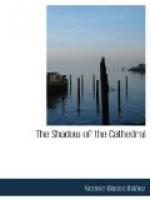The gardener spoke with pride of his descent, of his noble and unfortunate relative the constable Don Alvaro, buried like a king in his chapel behind the high altar; of the Pope Benedict XIII., proud and obstinate like all the rest of his family; of Don Pedro de Luna, fifth of his name to occupy the archiepiscopal throne of Toledo, and of other relatives not less distinguished.
“We are all from the same stem,” he said with pride. “We all came to the conquest of Toledo with the good King Alfonso VI. The only difference has been, that some Lunas took a fancy to go and fight the Moors, and they became lords, and conquered castles, whereas my ancestors remained in the service of the Cathedral, like the good Christians they were.”
With the satisfaction of a duke who enumerates his ancestors, the Senor Esteban carried back the line of the Lunas till it became misty and was lost in the fifteenth century. His father had known Don Francisco III. Lorenzana, a magnificent and prodigal prince of the church, who spent the abundant revenues of the archbishopric in building palaces and editing books, like a great lord of the Renaissance. He had known also the first Cardinal Bourbon, Don Luis II., and used to narrate the romantic life of this Infante. Brother of the King Carlos III., the custom that dedicated some of the younger branches to the church had made him a cardinal at nine years old. But that good lord, whose portrait hung in the Chapter House, with white hair, red lips and blue eyes, felt more inclination to the joys of this world than to the grandeurs of the church, and he abandoned the archbishopric to marry a lady of modest birth, quarrelling for ever with the king, who sent him into exile. And the old Luna, leaping from ancestor to ancestor through the long centuries, remembered the Archduke Alberto, who resigned the Toledan mitre to become Governor of the Low Countries, and the magnificent Cardinal Tavera, protector of the arts, all excellent princes, who had treated his family affectionately, recognising their secular adhesion to the Holy Metropolitan Church.




